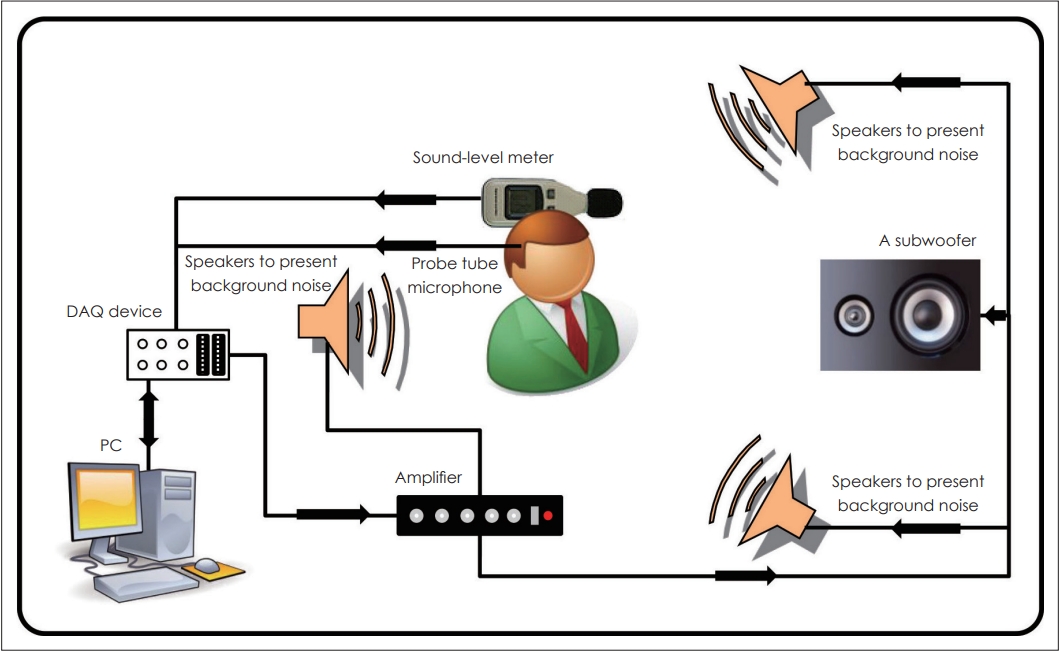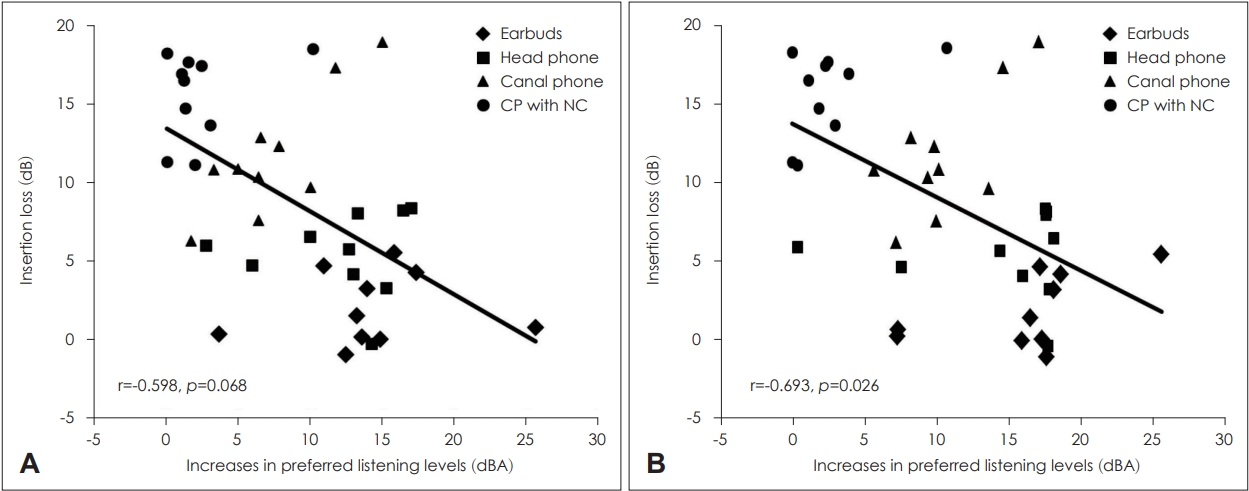Effects of an Active Noise Control Technology Applied to Earphones on Preferred Listening Levels in Noisy Environments
Article information
Abstract
Background and Objectives
The harmful effects of frequent exposure to loud sounds through portable music players (PMPs) in combination with earphones have been suggested to result in a high prevalence of recreational noise-induced hearing loss among children, adolescents, and young adults. The present study aimed to evaluate the effects of an active noise control technology applied to earphones on the preferred listening levels (PLLs) while listening to music in the presence of background noise.
Subjects and Methods
Twenty-three adults between 20 and 40 years with normal hearing were recruited for this study. PLLs for listening to pop-rock and classical music were measured in the participants’ ear canal with a commercially available PMP for four earphone/headphone configurations in quiet and noisy conditions. Ear canal insertion loss was measured in open ear conditions as well as earphone/headphone conditions.
Results
The average PLL while using earphones and headphones exceeded 85 dBA corresponding to the sound level to induce hearing damage, but in the case of canal earphones with noise cancelling (NC), it was below 75 dBA, corresponding to potentially harmful levels. The background subway noise significantly increased the PLL measured in quiet conditions using any four earphone/headphone types except canal earphones with NC. Canal earphones with NC showed the lowest PLLs compared with participants’ average PLLs using the other three earphone/headphone types.
Conclusions
To minimize recreational noise exposure at the risk of PMP use, the use of earphones with NC is recommended in noisy environments.
Introduction
The World Health Organization (WHO) estimates that 1.1 billion young people worldwide could be at risk of hearing loss due to unsafe listening practices. Nearly half of all teenagers and young adults (12 to 35 years old) in middle- and high-income countries are exposed to unsafe levels of sound from the use of personal audio devices and some 40% of them are exposed to potentially damaging sound levels at clubs, discotheques and bars [1]. Analysis of data from the National Health and Nutrition Examination Survey in the United States (US) suggests that, between 1994 and 2006, the prevalence of hearing loss among teenagers (12 to 19 years old) rose from 3.5% to 5.3% [2]. Another study from the US indicates that the number of individuals listening to music through headphones and earphones increased by 75% between 1990 and 2005 [3].
The harmful effects of frequent exposure to loud sounds through earphones have been suggested to result in a high prevalence of recreational noise-induced hearing loss in children, adolescents, and young adults [4]. According to WHO [5], a sound level above 75 dBA can potentially harm hearing, and a sound level above 85 dBA can induce hearing damage if the daily exposure is more than 1 hour. Currently, the risk of recreationally induced hearing loss corresponds to a threshold of 85 dBA for 4 hours by Portnuff [6] and 80 dBA for 8 hours, as determined by Neitzel and Fligor [7]. Portable music players (PMPs), including mobile phones and tablets in combination with headphones, are often used on a daily basis. The maximum output levels from headphones can exceed safe levels. Although preferred listening levels (PLLs) in quiet environments may be at acceptable levels, listeners significantly increase their PLL in the presence of background noise [8]. The use of isolating canal earphones has been shown to allow the listener to decrease their PLL [9]. Henry and Foots [10] demonstrated a significant effect from an earphone configuration that follows the levels of insertion loss provided by different earphones. The amount of insertion loss provided by the earphones is followed by earbuds in combination with earmuffs, in-the-ear earphones, and earbuds. In selecting appropriate earphones, the selection of in-the-ear earphones with a moderate degree of insertion loss may be advantageous since the use of muffs is not practical and would be rejected by most users in spite of the greater degree of insertion loss [10]. However, the effect of an active noise control applied to earphones on the PLL for listening music in the presence of background noise has not yet been evaluated.
With advances in technology, an active noise cancelling (NC) technique can now be applied to headphones and this may help mitigate the problems created by low frequency noise [11]. The resultant NC headphones have built-in microphones outside the headset that input the external ambient noise and, inside the headset, microphones that input residual noise leaking into the ear cups through cable passageways and gaps between the headphones and ear cushions. Such a ‘duo microphone’ system can capture most surrounding noise and send the assembled signals to an active noise control system that generates an anti-noise signal of equal amplitude but 180° out-of-phase to the captured noise. This anti-noise signal is emitted via the headset speakers and is superimposed on the primary noise signal to cancel noise near the listener’s tympanic membrane [12,13].
In the present study, we evaluated the increase in the PLL in environments with background noise when two types of music, pop-rock and classical, are presented to participants using different earphone/headphone configurations such as earbuds, headphones, canal earphones, and canal earphones equipped with NC. Furthermore, the degrees of ear canal insertion loss across the frequency provided by the different earphones/headphones in noise environments were determined.
Subjects and Methods
Participants
Twenty-three adults (19 males, 4 females) between 20 and 40 years were recruited from Department of Otorhinolaryngology, Juntendo University Faculty of Medicine, and Department of Mechanical Engineering and Intelligent Systems, Graduate School of Informatics and Engineering, The University of Electro-Communications. All the participants affirmed that they had no history of otological diseases. Normal hearing was defined as air conduction thresholds less than 20 dB hearing level in both ears at octave intervals between 250 and 8,000 Hz using a calibrated audiometer and supra-aural earphones (AA-H1, RION, Tokyo, Japan). This study was approved by the ethics committee of Juntendo University Faculty of Medicine and informed consent was obtained from all subjects (IRB No. 16-092).
Equipment and setting
The layout of the experimental setting is shown in Fig. 1. Each participant was seated in the center of a 4.1 m×4.1 m soundproof room. Background noise was 60 second of subway noise recorded inside a subway carriage in Tokyo during rush-hour. The level of the background noise at a distance of 20 cm from the head of the participant was 80 dBA. The noise was presented from three sound-field speakers (PS-S202, Victor, Tokyo, Japan) at both frontward sides of the participant and just behind the participant. The low-frequency region of the background noise was provided by a subwoofer (SP-DW103, Victor) facing the participant. An ER-7C-SERIES-B probe tube microphone (Etymotic, Elk Grove Village, IL, USA) was connected to a laptop computer via a DAQ device (NI USB-6251, National Instruments, Austin, TX, USA) for recording in the participants’ ear canals at a depth of 25 mm from the intertragal notch and secured to the participant’s earlobe with tape. Participants were presented 90 seconds of the pop-rock song “Zenzenzense” by RADWIMPS and the classical music “Jupiter in The Planets” by Gustav Holst played through an Apple iPod 2nd Generation Nano. There were 4 earphone/headphone configurations (Fig. 2): earbuds (MD827FE, Apple, CA, USA), headphones (ATH-WS770, Audio Technica, Tokyo, Japan), canal earphones (ATH-CKR3, Audio Technica), and canal earphones with a noise-cancelling option (CP with NC) (ATH-ANC23, Audio Technica). The CP with NC was tested in only 10 of the participants.
Experimental procedures
First, one of the four configurations was tested in a quiet condition (i.e., in a sound-proof room without background noise). The participants were instructed that the volume of the PMP could be freely adjusted to his/her adequate level, and the sound level in the ear canal after the adjustment was defined as the PLL. The process of establishing the PLL was repeated three times. Next, the same tests were performed under the noisy condition using the same configuration. The participants adjusted the volume of the PMP to their own PLL from that in the quiet condition. The other configurations were also tested in the quiet and noisy environments in the same way. Equivalent continuous A-weighted sound pressure levels (LAeq) for 1-minute period were calculated in LabVIEW (ver. 12.0.1, National Instruments, Austin, TX, USA) analysis software, and the level of the music averaged over the three trials served as the dependent measure of PLL per condition. Fast Fourier transform analyses were carried out for the noise recordings.
Finally, in order to analyze the insertion loss of the noise provided by each earphone/headphone, the difference in white noise recorded in the ear canal between the open ear conditions and the earphone/headphone conditions was calculated. The white noise was generated using the LabVIEW software and presented from the three sound-field speakers mentioned above.
Statistical analysis
The data were expressed as the mean±SD. Statistical analyses were evaluated using StatMate IV for Windows (ATMS Co., Tokyo, Japan). A two-factor, repeated-measures analysis of variance (ANOVA) was conducted on the PLLs measured in the right ear with noise condition and earphone/headphone configuration as independent variables. The post-hoc correction of Holm-Bonferroni was used when multiple comparisons were performed. Pearson’s correlation coefficient was used for the relationship between the individual increase in PLL and individual insertion loss given by the earphone/headphone configuration. Differences were considered to be significant if p<0.05.
Results
Fig. 3 shows the average PLL (in dBA) for listening to the pop-rock and classical music measured in the right ear canal using four earphone/headphone configurations in the quiet and noise conditions. The PLLs for listening to both types of music ranged from 65 to 80 dBA in the absence of noise and from 70 to 90 dBA in the presence of noise. In the presence of background noise, the average PLL using earbuds and headphones exceeded 85 dBA, but using canal earphones with NC it was below 75 dBA. Significant elevations of the PLL in the noise conditions listening to both types of music were observed in all the earphone/headphone configurations except the canal earphones with NC as compared to the quiet conditions. Table 1 shows the number of the participants who exceeded 75 dBA of the PLL in each earphone/headphone configuration.
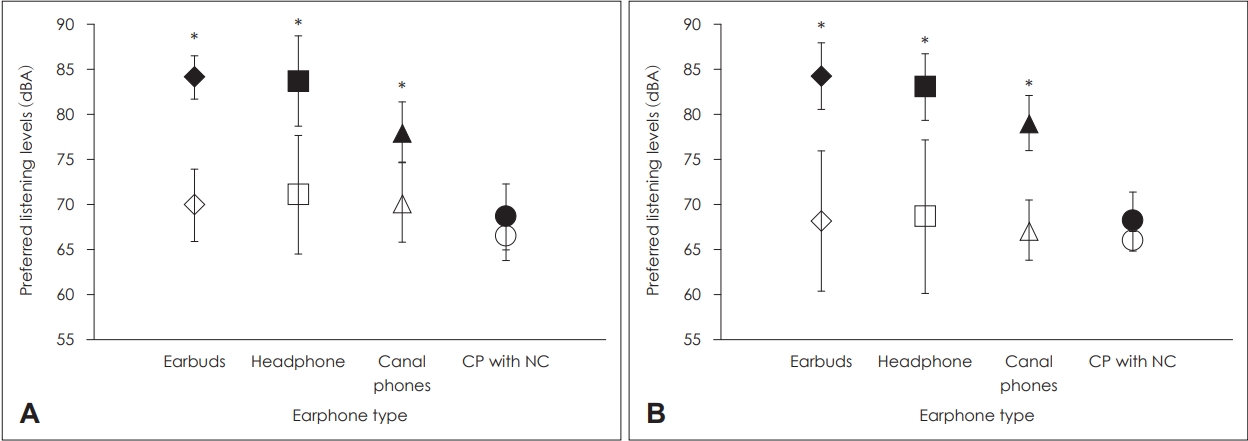
The average preferred listening levels of (A) pop-rock music and (B) classical music for earbuds (n=23), headphone (n=23), canal earphones (n=23), and CP with NC (n=10) in quiet and noisy conditions. Each value in headphone, canal earphones, and CP with NC is statistically compared with that in earbuds. Open symbols: quiet environment; closed symbols: noise environment; vertical bars: standard deviation. *p<0.01. CP, canal earphones; NC, noise cancelling.
Increases in PLL were calculated for each earphone/headphone by subtracting the PLL selected in the quiet condition from that selected in the noise condition. When listening to the pop-rock music, marked increases were observed in earbuds and headphones, both of which were significantly higher than those in canal earphones without and with NC. However, there was no significant difference in the PLL increase between the canal earphone with and without NC (Fig. 4A). The patterns of the PLL increase among the four types of earphone/headphone configurations in the classical music were similar to those in the pop-rock music, except that the canal earphone with NC showed a significantly smaller increase of the PLL as compared with the canal earphone without NC (Fig. 4B). There were no differences in the PLL increase between earbuds and headphones for either the pop-rock or classical music.
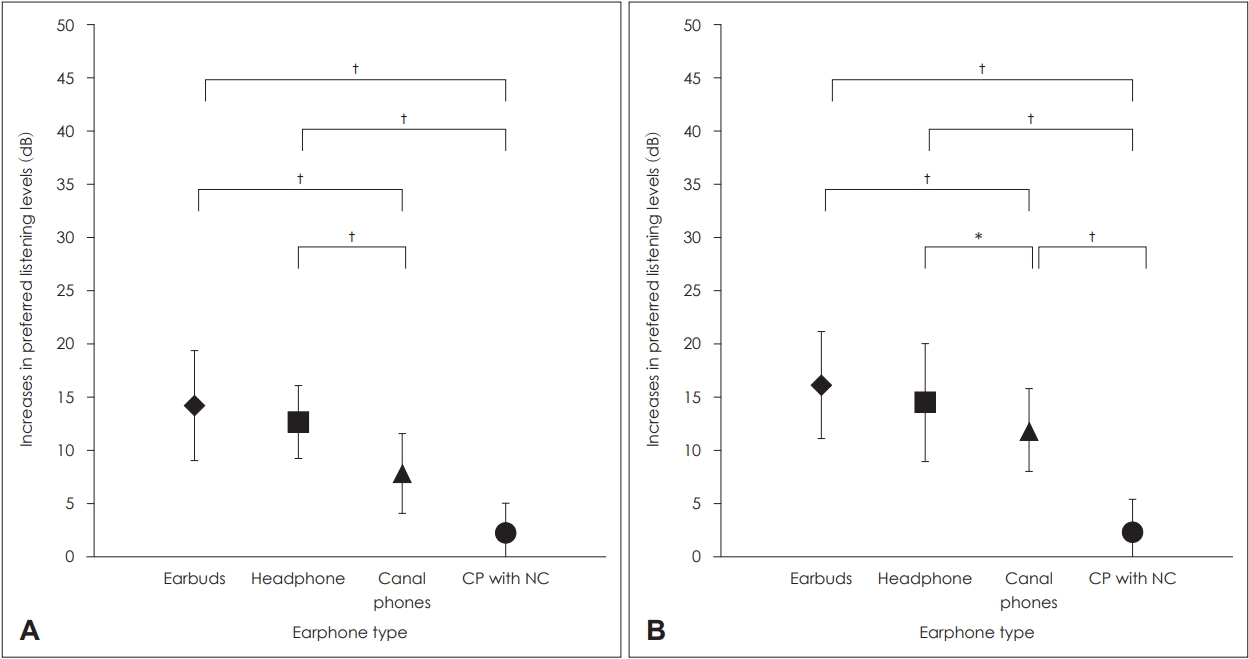
The increases in preferred listening levels calculated for earbuds (n=23), headphone (n=23), canal earphones (n=23), and CP with NC (n=10) by subtracting the preferred listening levels selected in a quiet condition from that selected in a noisy one, when listening to (A) pop-rock music and (B) classical music. *p<0.05; †p<0.01. CP, canal earphones; NC, noise cancelling.
Fig. 5 shows the ear canal insertion loss across the frequency calculated as the difference between the noise in the earphone/headphone condition and in the open ear condition. Insertion loss was greatest in the canal earphone with NC, followed by the canal earphone without NC, and earbuds/headphone provided almost no insertion loss at low frequencies (250, 500 Hz and 1 kHz). At high frequencies (2, 4 and 8 kHz), no significant difference between canal earphones with and without NC was observed, whereas earbuds and headphones showed less insertion loss as compared with canal earphones (Fig. 6). The sound pressure levels of the insertion loss averaged at each frequency in individual participants were plotted against the increases in their PLLs (Fig. 7). The increase in PLL was higher when the ear canal insertion loss was lower, and the relationship between the increase in PLL and the ear canal insertion loss was significantly correlated for classical music (r=-0.693, p=0.026) but not for pop-rock music (r=-0.598, p=0.068).
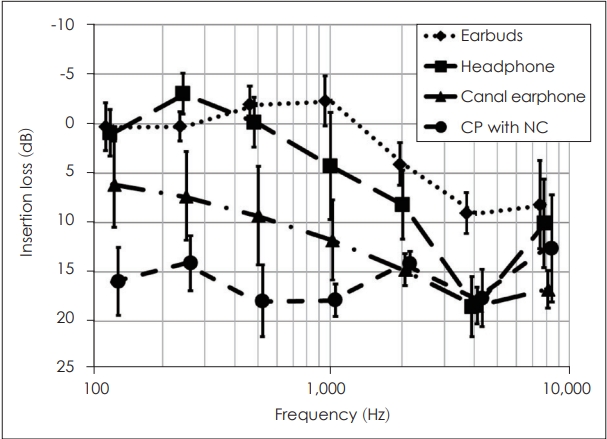
Ear canal insertion loss across the frequency calculated as the difference between the noise in the earbuds (n=23), headphone (n=23), canal earphones (n=23), and CP with NC (n=10) condition and open ear condition. The values are expressed as means+standard deviation. CP, canal earphones; NC, noise cancelling.
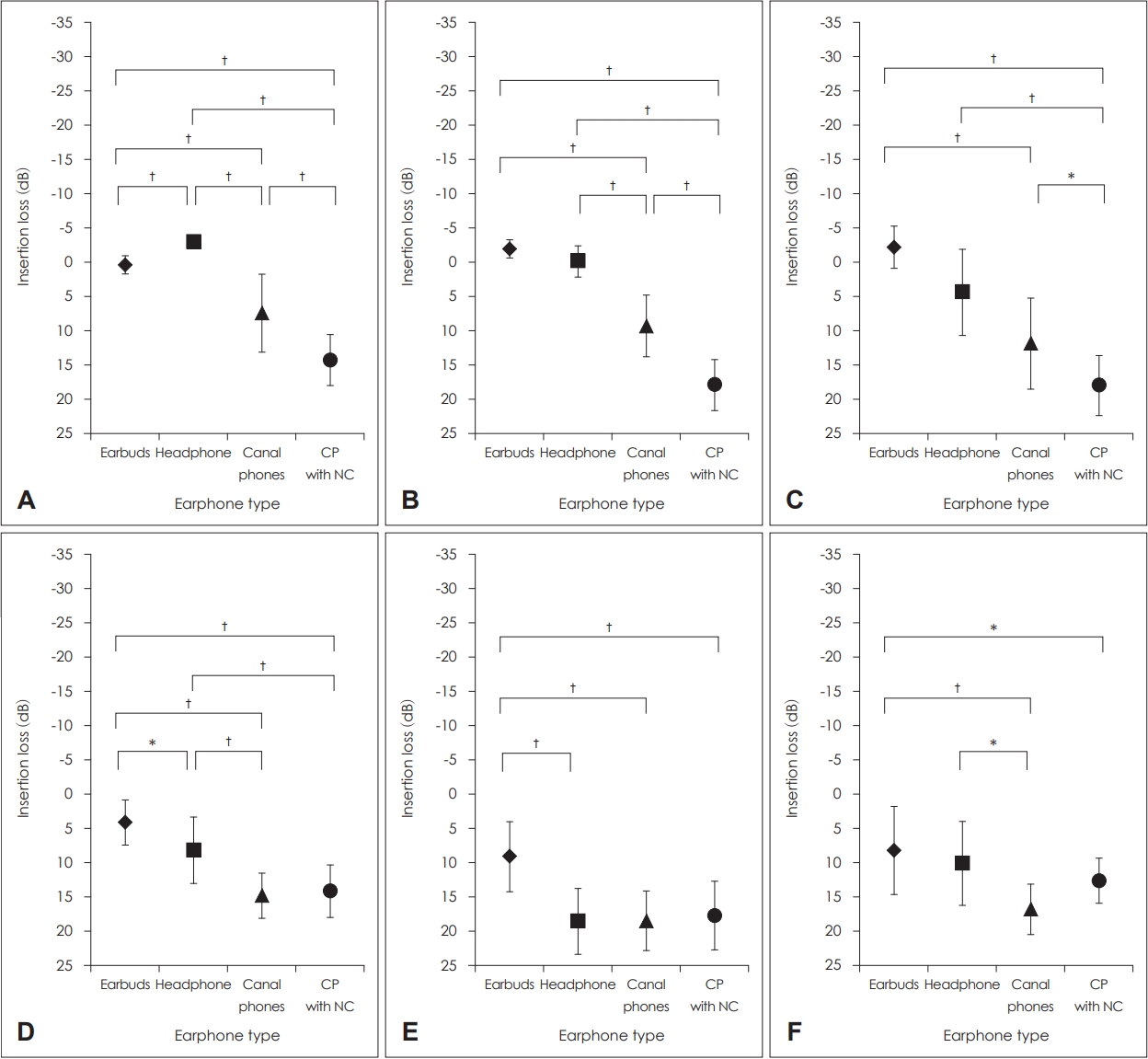
Comparison of ear canal insertion loss among earbuds (n=23), headphone (n=23), canal earphones (n=23), and CP with NC (n=10) at (A) 250 Hz, (B) 500 Hz, (C) 1 kHz, (D) 2 kHz, (E) 4 kHz, and (F) 8 kHz. *p<0.05; †p<0.01. CP, canal earphones; NC, noise cancelling.
Discussion
A sound level above 85 dBA can induce hearing damage and 75 dBA can potentially harm hearing [5]. In this study, we did not measure the head related transfer function (HRTF) in each subject. However, for 10 of the measured subjects, the sound pressure in the ear canal of the bare ear was measured in the presence of 80 dBA background noise (white noise). At most frequencies, the sound pressure in the ear canal was 0 to 10 dB lower than the room sound pressure, and was up to 7 dB higher only in the frequency range of 200 Hz to 300 Hz. Therefore, the equivalent background noise level would be at least higher than the value obtained by subtracting the 7dB from the equivalent sound pressure level in the ear canal. This means that PLL above 92 dBA can induce hearing damage and 82 dBA can potentially harm hearing. The present study provided new findings as follows. The PLLs in the presence of background noise using earbuds and headphones exceeded 85 dBA, whereas canal earphones with NC showed PLLs reduced to below 75 dBA. In addition, our results showed 1) that the background noise of subway noise significantly increased the PLL compared to that measured in quiet conditions using any of the four different earphone/headphone configurations except canal earphones with NC, 2) that the increases in PLL using headphones and earbuds were significantly higher than those using canal earphones with and without NC in listening to both pop-rock and classical music, 3) that the increase in PLL was significantly higher in the earphone without NC than in that with NC when listening to classical music, but not when listening to pop-rock music, 4) that ear canal insertion loss in earphones was significantly reduced as compared with those in earbuds and headphones, 5) and that the relationship between the increase in PLL and the ear canal insertion loss was correlated.
Our findings agreed with those of previous reports that the PLL for listeners was higher in a noisy background than in a quiet one [9,10,14,15]. Various types of earphones/headphones have been evaluated for the insertion loss of background noise. Although earbuds do not provide sufficient insertion loss of background noise, earphones, headphones, and headphones with NC algorithms do [9,10]. Our results, however, showed that these headphones provided insufficient insertion loss of the background noise, as do earbuds. The discrepancy between our results and those of the previous study is probably due to differences in the type and properties of the headphones used. However, this study included a limited number of devices with a small number of participants, and our inference was based on only one tested model for each style of headphone.
It should be emphasized that the present study first demonstrated that earphones with NC taking the greatest advantage of noise insertion loss resulted in the greatest reduction in the PLL when listening to classical music in the presence of background noise. This can be explained by the active NC circuit having a capacity to filter out the low frequencies since the frequency spectra of classical music contains much lower frequency components than those of pop-rock music (Hoshina et al., unpublished data, 2022). However, with pop-rock music, the PLL increase in the earphones with NC showed the lowest value regardless of the significant difference with that in the earphones without NC.
Henry and Foots [10] proved the idea that the degree of the PLL increase with earphones/headphones in the presence of background noise is dependent upon ear canal insertion loss provided by earphone/headphone style. They compared the average insertion loss provided by three types of earphones/headphones to the increase in PLL, leading to the conclusion that the correlation for this relationship based on three points was significant. In our study, a detailed analysis of the relationship between the increase in PLL and ear canal insertion loss was performed. Based on the data of individual participants, a significant inverse relationship between the increase in PLL and ear canal insertion loss was obtained for classical music. For pop-rock music, a relatively good correlation was observed, but it was not significant. The difference in the relationship of the two factors between classical and pop-rock music may result from differences in the frequency spectra of subway noise, classical and pop-rock music, and the frequency characteristics of earphones/headphones. Thus, our meticulous study clarified that the increase in PLL in a noisy environment is determined by ear canal insertion loss provided by earphones/headphones.
In order to prevent excessive recreational noise exposure created by the use of a PMP in the presence of background noise, the present study provides evidence that the use of canal earphones with NC could reduce the increase in PLL. Active noise control can decrease the amount of background noise arriving at the listener’s ears in addition of passive process of obstructing the ears by earphones, resulting in a further benefit to the listener by a lower PLL selection. Recently, 1 in 7 children aged 9 to 11 years have been reported to show high-frequency hearing loss [16]. This finding suggests a possible association of PMP use with hearing impairment. Early education on the risks of PMP use in children and young adolescents is required as well as sufficient intervention to lower the PLL of PMP.
In conclusion, we examined the PLL of a PMP using four types of earphones/headphones in the background noise. Canal earphones with NC alone lowered the PLL to safe levels of sound pressure as compared with earbuds, headphones, and earphones without NC. The increase in PLL was found to be determined by ear canal insertion loss provided by earphones/headphones. To minimize recreational noise exposure from PMP use, the use of earphones with NC is recommended when listening in noisy environments.
Acknowledgements
This work was supported in part by grants-in-aid (15K00737) to Kstsuhisa Ikeda and Takuji Koike from the Ministry of Education, Sports, Science and Culture of Japan.
Notes
Conflicts of interest
The authors have no financial conflicts of interest.
Author Contributions
Conceptualization: Takuji Koike, Katsuhisa Ikeda. Data curation: all authors. Funding acquisition: Takuji Koike, Katsuhisa Ikeda. Investigation: Takunari Hoshina, Daiki Fujiyama,. Supervision: Takuji Koike, Katsuhisa Ikeda. Writing—original draft: Takuji Koike, Katsuhisa Ikeda. Writing—review & editing: Takuji Koike, Katsuhisa Ikeda. Approval of final manuscript: all authors.

